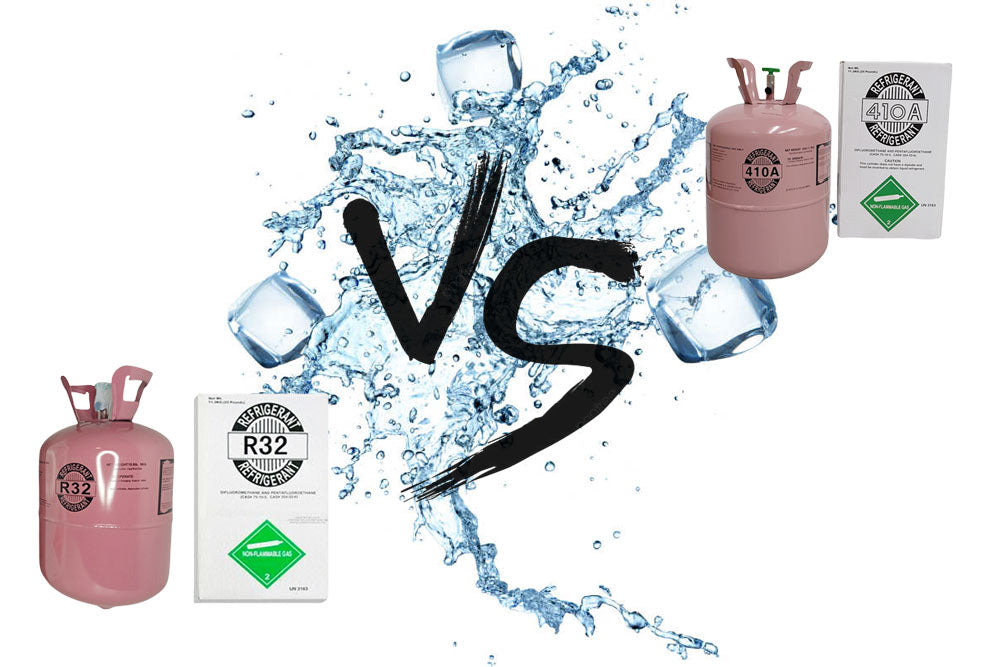R32 and R410A refrigerants: in-depth analysis of technological innovation and environmental challenges
In the air conditioning and refrigeration industry, the choice of refrigerant is not only related to energy efficiency and performance, but also becomes a weathervane for environmental protection policies and technological development. As the two mainstream refrigerants, R32 and R410A are leading the industry's transformation from high global warming potential (GWP) refrigerants to low environmental impact solutions. This article will analyze from multiple dimensions such as technical characteristics, environmental impact, market trends and practical applications to help readers fully understand the differences and future directions of these two refrigerants.
Comparison of technical characteristics: the game between performance and safety
R32
Composition and classification:
R32 is a single-component refrigerant (HFC-32), which belongs to the ASHRAE safety level A2L (slightly flammable but low toxicity), and its GWP value is 675, which is significantly lower than R410A.
Performance advantages:
High energy efficiency: The unit volume cooling capacity of R32 is about 30% higher than that of R410A. Under the same cooling capacity, it can reduce the volume of the compressor and reduce energy consumption.
Low temperature adaptability: In low temperature environments (such as northern winter), R32 has higher heating efficiency and is suitable for heat pump air conditioners.
Environmental protection: The lower GWP value makes it meet the requirements of the Kigali Amendment to the Montreal Protocol on HFCs emission reduction.
Limitations:
Flammability: The slight flammability (A2L level) of R32 requires additional safety protection when designing equipment, such as limiting the refrigerant charge and using flame retardant materials.
Pressure adaptability: R32 has a lower critical temperature (about 96°C) and has higher system pressure requirements, which may require upgrading the compressor and piping materials.
R410A (a mixture of pentafluoroethane and difluoromethane)
Composition and classification:
R410A is a mixed refrigerant of R32 (50%) and R125 (50%), which belongs to the non-flammable ASHRAE A1 safety level and has a GWP value of 2088.
Performance advantages:
Stability: Non-flammability makes it safer during installation and maintenance, and suitable for the transformation and upgrading of existing equipment.
High-pressure performance: The critical temperature of R410A is as high as 102℃, allowing the system to operate at a higher pressure and improve heat exchange efficiency.
Compatibility: As a transitional refrigerant, R410A has good compatibility with existing air-conditioning equipment, reducing the cost of replacing the system.
Limitations:
High GWP value: Its GWP value is much higher than R32, which does not meet long-term environmental protection goals, and many countries have restricted its use.
Energy efficiency bottleneck: In extremely low temperature environments, the heating efficiency of R410A may be lower than that of R32.
The thermodynamic properties of refrigerants directly affect the working efficiency of equipment.
Refrigeration capacity:
The unit volume refrigeration capacity of R32 is about 10% higher than that of R410A, which means that the R32 system may be more compact under the same cooling demand.
Energy efficiency ratio (EER/COP): R32 has higher thermal conductivity and smaller flow resistance, and can usually achieve higher energy efficiency. Experimental data show that under the same working conditions, the energy efficiency of the R32 system is 5%-10% higher than that of R410A.
Working pressure: The working pressure of R410A is about 1.6 times higher than that of R32, and the pressure resistance requirements of the system pipeline and compressor are higher, which indirectly increases the cost.
Conclusion:
R32 has more advantages in energy efficiency and system design flexibility.
Safety trade-off
The safety of refrigerants needs to focus on flammability and toxicity (ASHRAE standard classification):
R410A: Belongs to Class A1 (non-flammable, low toxicity), no special explosion-proof measures are required for installation and maintenance, and it is relatively safe.
R32: Belongs to Class A2L (low flammability, low toxicity). Although its lower flammability limit (LFL) is 14.4%, which is higher than common combustibles such as propane, leakage in confined spaces must still be avoided. During installation, safety standards such as IEC 60335-2-40 must be met, such as limiting the charge amount and strengthening ventilation design.
Controversy:
Although R32 has a lower combustion risk, its promotion still depends on strict safety regulations and technical training.
Consumer Selection Guide: How to weigh R32 and R410A?
1. Environmentally friendly users
Choosing air conditioners with R32 refrigerant, especially in areas with strict policies (such as the EU and China), can avoid the risk of future equipment obsolescence.
2. Safety and cost-sensitive users
R410A is better in safety and has a lower initial purchase cost, which is suitable for users who are price-sensitive or live in complex environments (such as old buildings).
3. Users in extreme climate areas
R32 has better heating performance in low temperature environments (such as northern winter), which is suitable for areas that require efficient heating.

